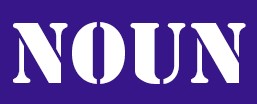Noun:
A noun is a part of speech that functions as the name of a person, place, thing, idea, or concept. Nouns are essential building blocks of sentences and play a central role in language by providing the subjects and objects of verbs, as well as the complements of prepositions.
Nouns can be further categorized based on various characteristics:
1. Common Nouns:
These are general names for people, places, things, or ideas. They are not specific to any individual or entity and are typically not capitalized unless they begin a sentence. Examples include “dog,” “city,” “book,” and “love.”
They are typically not capitalized unless they begin a sentence.
Countable Nouns :
Countable nouns are nouns that can be counted as individual items. They have both singular and plural forms. Examples include “apple” (singular) and “apples” (plural).Countable nouns are nouns that can be counted as individual items.
They have both singular and plural forms.
Singular Countable Nouns :
Examples : Dog, Cat, Book, Chair
Plural Countable Nouns :
Examples : Dogs, Cats, Books, Chairs
Uncountable Nouns :
Uncountable nouns cannot be counted as separate items because they represent mass or abstract concepts. They are used in the singular form. Examples include “water,” “knowledge,” and “happiness.”Uncountable nouns cannot be counted as separate items because they represent mass or abstract concepts.
They are used in the singular form.
Examples : Water, Love, Knowledge, Music
2. Proper Nouns:
Proper nouns are specific names for individual people, places, things, or organizations. They are always capitalized to distinguish them from common nouns.
Examples include “John” (person), “Paris” (city), “Mona Lisa” (artwork), and “NASA” (organization).
Person’s Names :
Examples : John, Mary, Steve,
Place Names :
Examples : New York City, Eiffel Tower, Amazon River
Thing Names :
Examples : iPhone, Coca-Cola, Mona Lisa
Organization Names :
Examples : Apple Inc., United Nations, Harvard University
3. Collective Nouns:
Collective nouns refer to groups of people or things as a single entity. Examples include “team,” “herd,” “family,” and “flock.”Collective nouns refer to groups of people or things as a single entity.
Examples : Team, Herd, Family, Flock
4. Concrete Nouns :
Concrete nouns refer to tangible, physical objects that can be perceived by the senses. Examples include “table,” “car,” “flower,” and “mountain.”Concrete nouns refer to tangible, physical objects that can be perceived by the senses.
Examples : Table, Car, Flower, Mountain
5. Abstract Nouns:
Abstract nouns represent intangible concepts, emotions, or qualities. They are often related to feelings, ideas, or states of being. Examples include “freedom,” “love,” “happiness,” and “knowledge.”Abstract nouns represent intangible concepts, emotions, or qualities.
Examples : Freedom, Love, Happiness, Knowledge
6. Compound Nouns:
Compound nouns are formed by combining two or more words to create a single noun. They can be written as separate words, hyphenated, or as one word.
Examples include “toothbrush,” “mother-in-law,” and “baseball.”Compound nouns are formed by combining two or more words to create a single noun. They can be written as separate words, hyphenated, or as one word.
7. Possessive Nouns :
These nouns show ownership or possession. They are formed by adding an apostrophe and an “s” (‘s) to the end of a noun. Examples include “John’s car” and “the dog’s leash.”Possessive nouns show ownership or possession. They are formed by adding an apostrophe and an “s” (‘s) to the end of a noun.
8. Plural Nouns :
Plural nouns refer to more than one person, place, thing, or concept. They are used when you want to talk about multiple instances or quantities of something. Forming plurals in English typically involves adding “-s” or “-es” to the end of the singular noun, but there are several rules and exceptions to be aware of. Here’s an explanation with examples:
a. Adding “-s” to Singular Nouns:
Regular Plurals :
In most cases, you can form a plural noun by simply adding “-s” to the end of a singular noun.
Examples :
Cat (singular) – Cats (plural)
Book (singular) – Books (plural)
Dog (singular) – Dogs (plural)
House (singular) – Houses (plural)
b. Adding “-es” to Singular Nouns (h2):
Singular Nouns Ending in -s, -x, -z, -sh, -ch :
When a singular noun ends in -s, -x, -z, -sh, or -ch, you generally add “-es” to form the plural.
Examples :
Bus (singular) – Buses (plural)
Box (singular) – Boxes (plural)
Quiz (singular) – Quizzes (plural)
Dish (singular) – Dishes (plural)
Church (singular) – Churches (plural)
c. Irregular Plurals (h2):
Some nouns have irregular plural forms that do not follow the typical “-s” or “-es” pattern. You need to memorize these irregular plurals.
Examples of Irregular Plurals :
Man (singular) – Men (plural)
Woman (singular) – Women (plural)
Child (singular) – Children (plural)
Foot (singular) – Feet (plural)
Tooth (singular) – Teeth (plural)
d. Plurals of Words Ending in -y :
d.1. Singular Nouns Ending in -y :
If a singular noun ends in a consonant + -y, change the -y to -ies to form the plural.
Examples :
Baby (singular) – Babies (plural)
City (singular) – Cities (plural)
Cherry (singular) – Cherries (plural)
Party (singular) – Parties (plural)
d.2. Singular Nouns Ending in -y (preceded by a vowel) :
If a singular noun ends in a vowel + -y, simply add -s to form the plural.
Examples :
Toy (singular) – Toys (plural)
Boy (singular) – Boys (plural)

